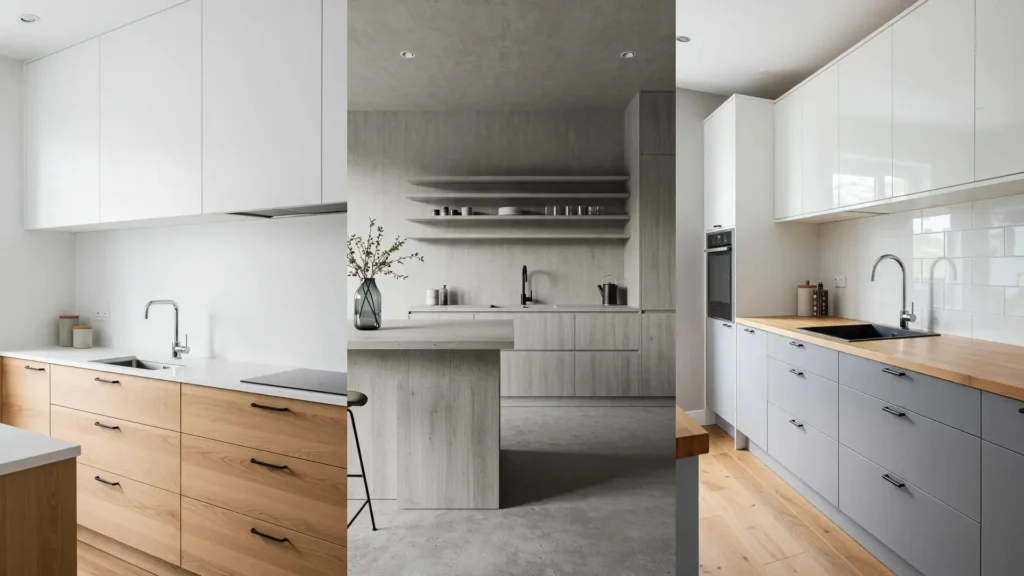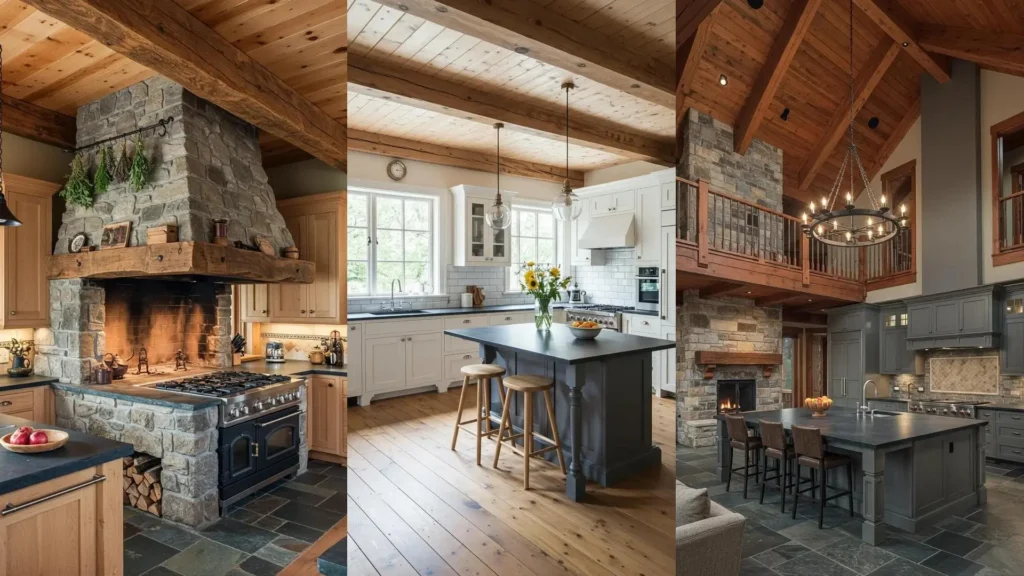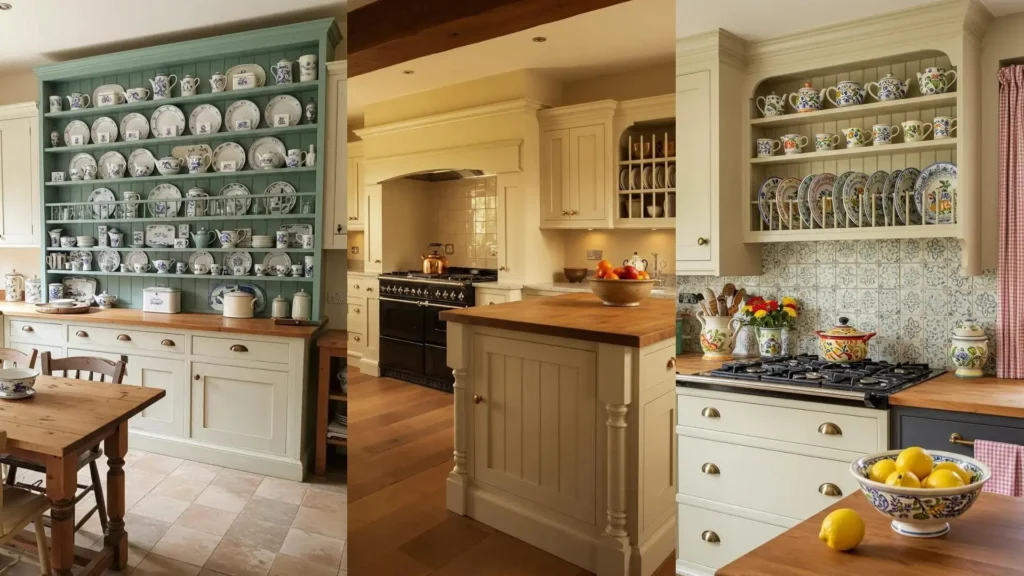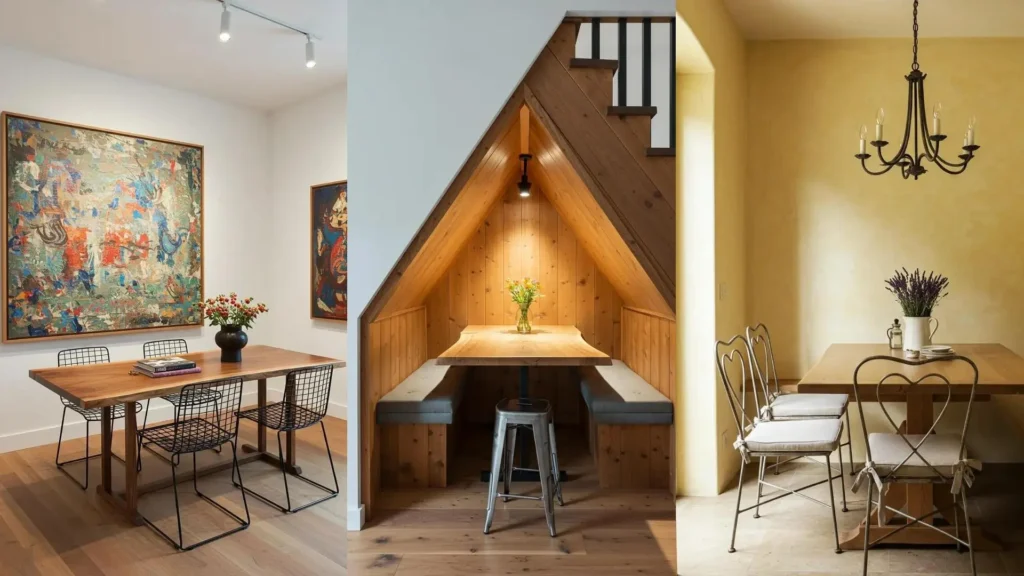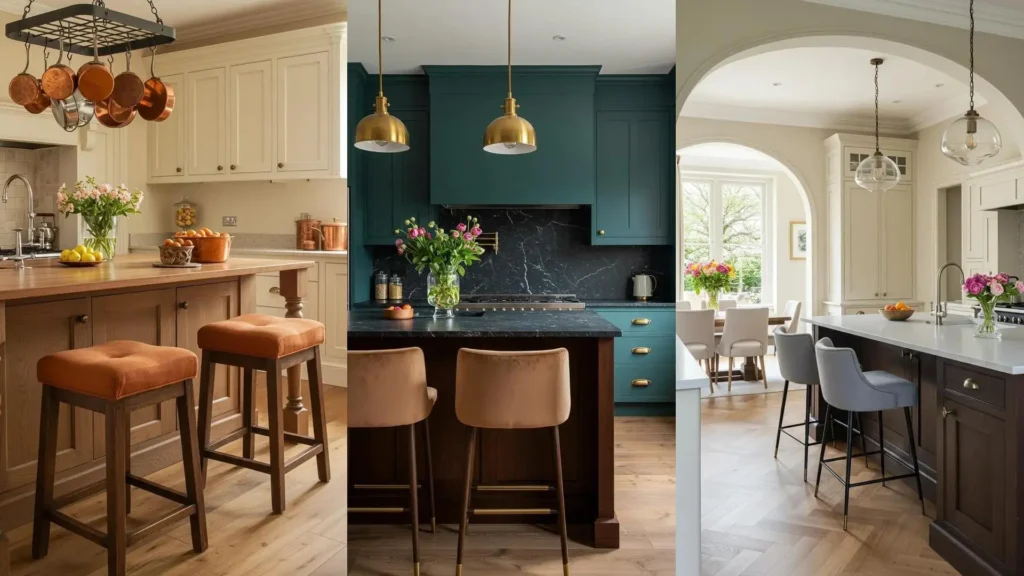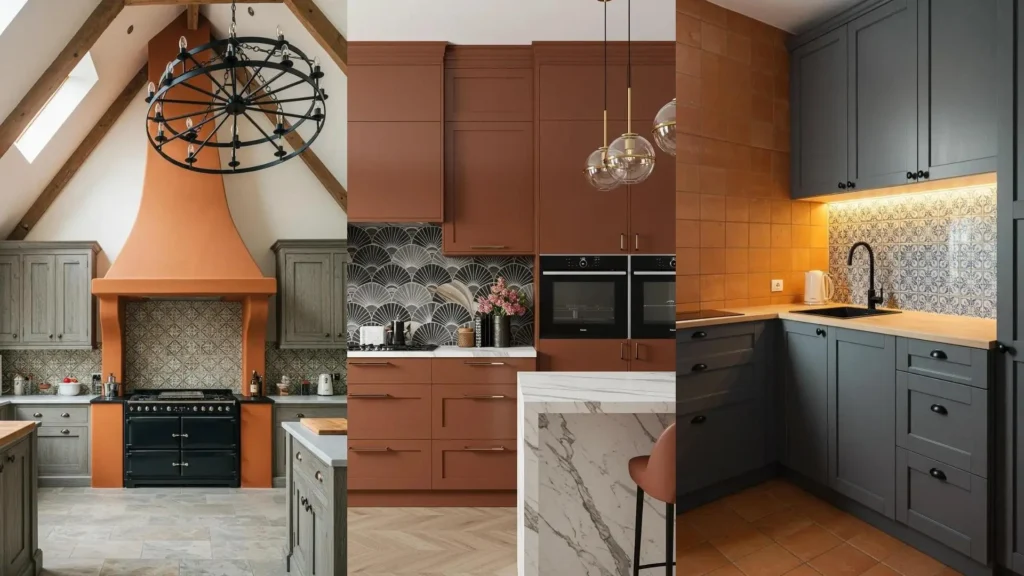A Scandinavian kitchen is more than just an aesthetic; it’s a feeling of calm, clarity, and intentionality.
It’s about creating a space that works beautifully and feels deeply personal, stripping away the excess to reveal what truly matters.
The warmth of light wood grounds the space in nature, while matte black hardware provides a clean, graphic contrast that feels both modern and timeless. Here is how you can bring that serene, functional elegance into your own home.
1. Ground Your Space with a Farmhouse Sink
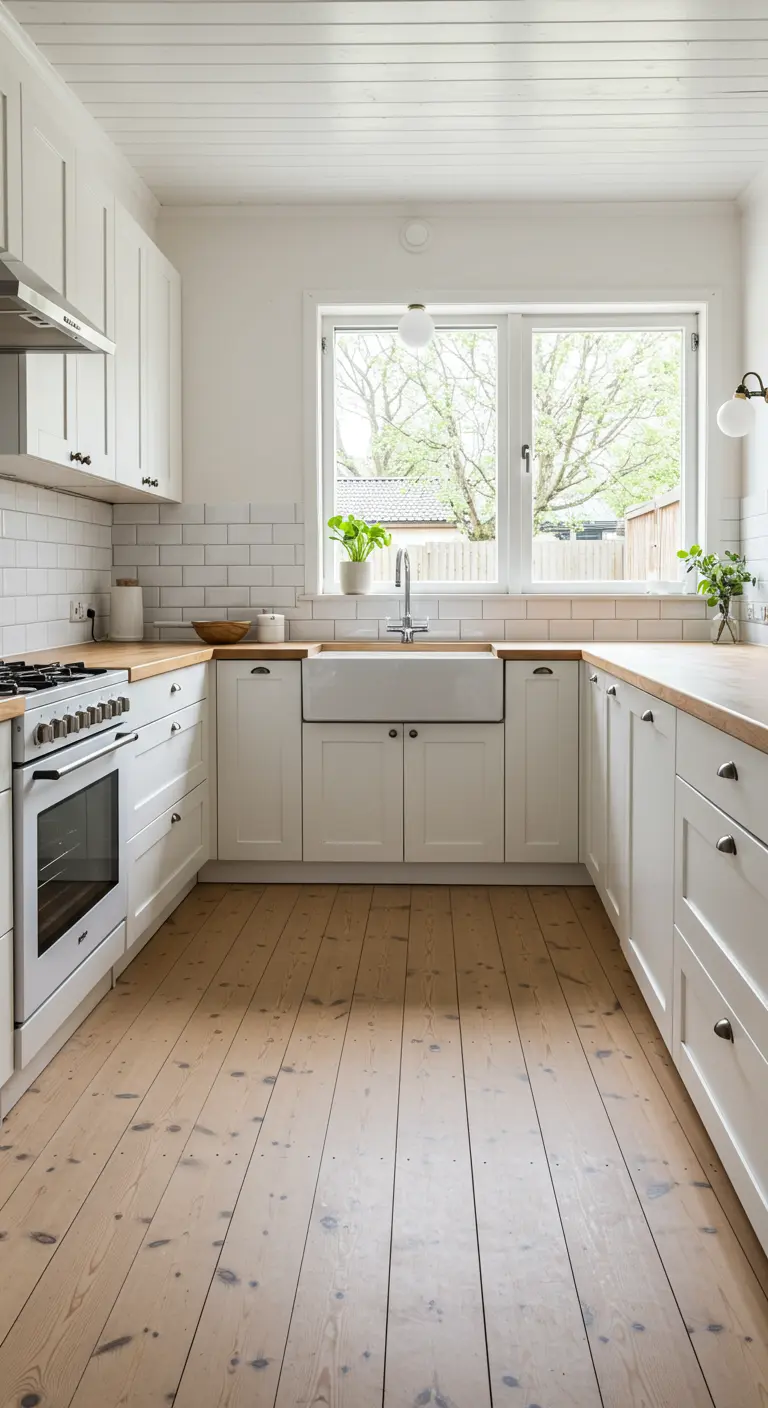
A deep apron-front or farmhouse sink acts as a beautiful, hardworking anchor in a U-shaped kitchen.
Its classic form adds a touch of rustic character that instantly feels established and timeless, balancing the clean lines of Scandinavian design.
Pair it with a simple, high-arc faucet in chrome or matte black to maintain a modern edge.
The continuous wood countertop wrapping around the sink enhances the feeling of warmth and cohesion.
2. Use Geometric Pendants for Sculptural Contrast
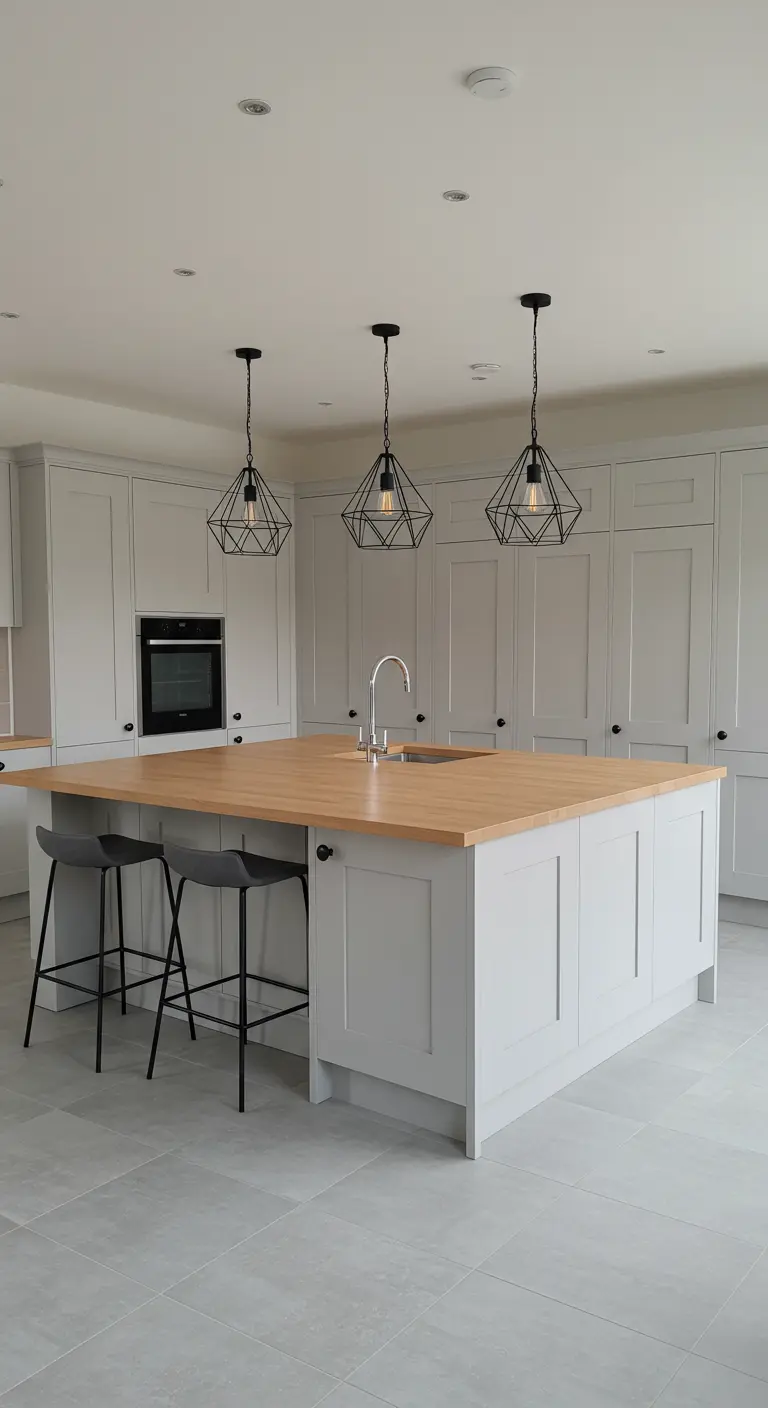
In a kitchen with clean, simple cabinetry, your lighting is an opportunity to add artistry.
These open-frame geometric pendants introduce a sharp, graphic element without adding visual bulk, which is key in a minimalist space.
They draw the eye and define the island as a central gathering point.
For a softer but equally impactful alternative, consider three identical dome pendants in a matte black finish to echo the hardware.
3. Create Balance in a Galley Kitchen
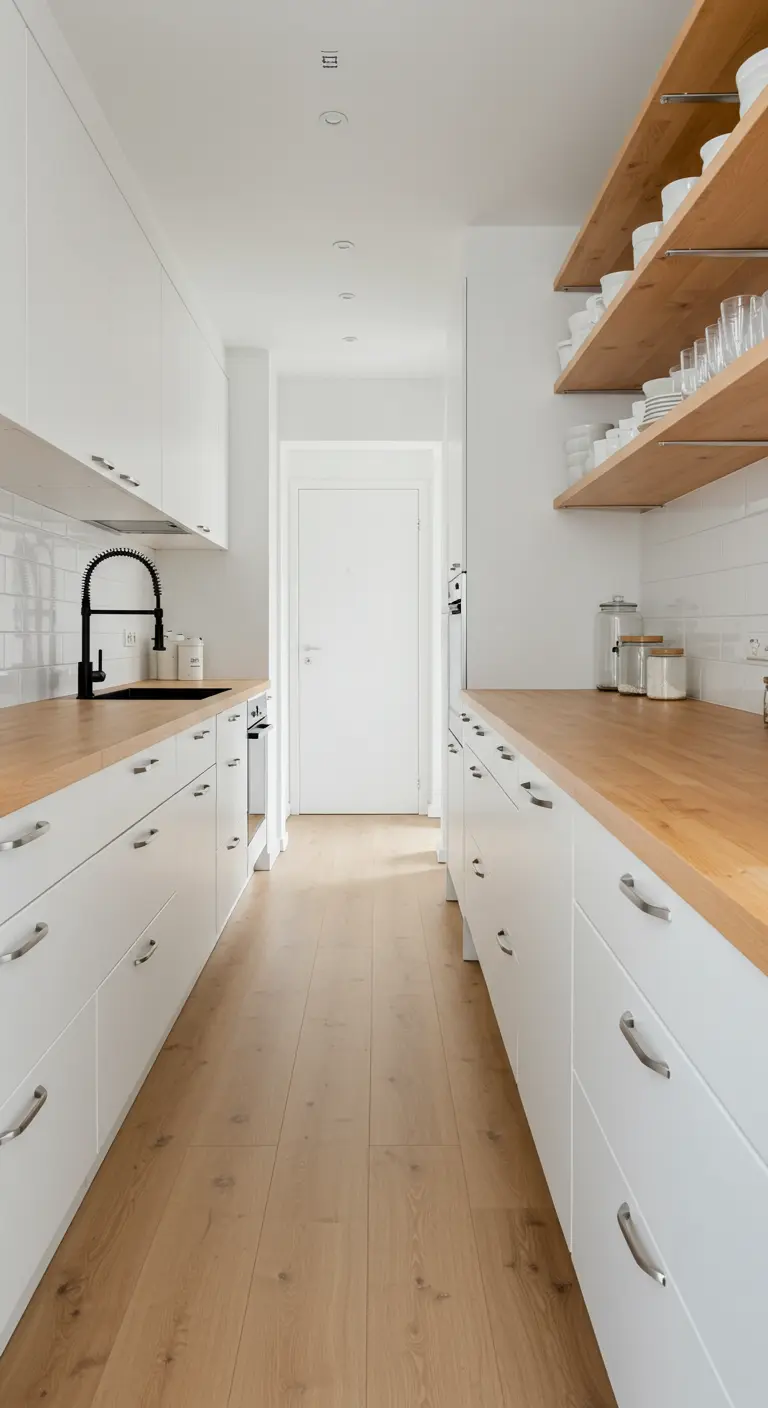
To prevent a narrow galley kitchen from feeling like a corridor, avoid perfect symmetry.
Here, one wall features enclosed upper cabinets for a clean, seamless look, while the opposite wall uses open wood shelving.
This asymmetrical approach opens up the space and creates distinct functional zones.
Use the open shelves for your most-used, beautiful items to keep them accessible and uncluttered.
4. Introduce Life with a Single Trailing Plant
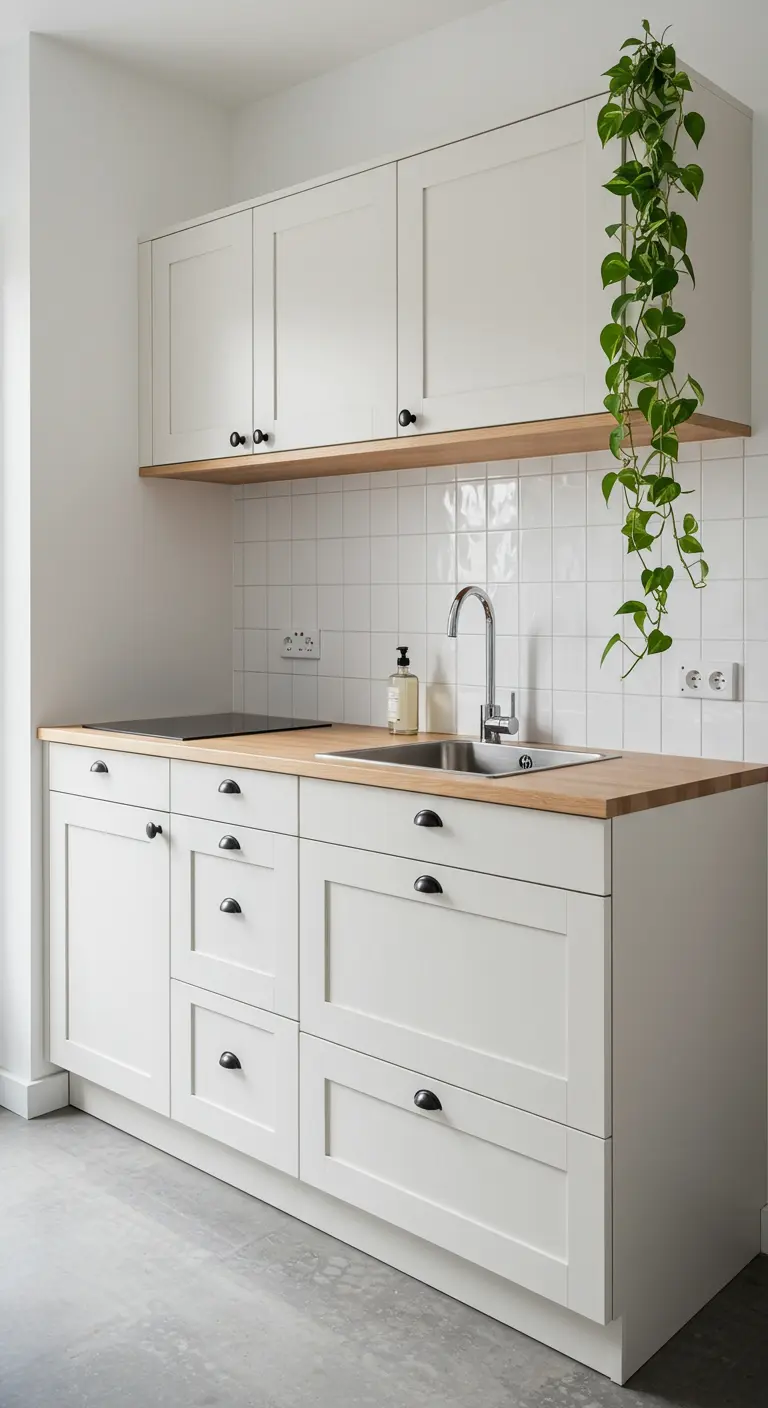
The fastest way to breathe life and softness into a structured, minimalist kitchen is with living greenery.
A single trailing plant, like a pothos, placed on top of a cabinet or a high shelf, is all you need.
Its organic form beautifully disrupts the straight lines of the cabinetry and adds a touch of gentle color without creating surface clutter.
5. Anchor a Dark Palette with a Pale Wood Island
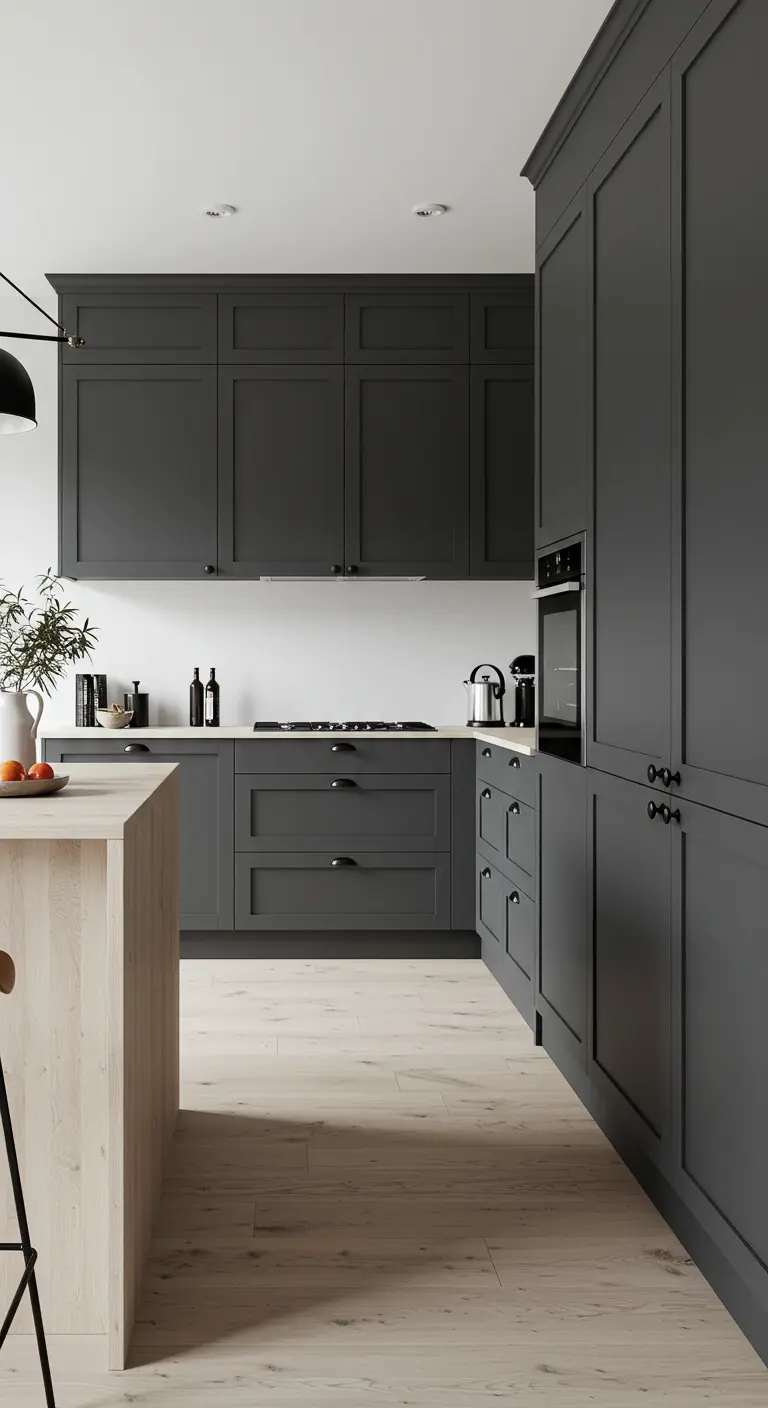
If you love the drama of dark cabinetry, use a light wood island as a warm, grounding counterpoint.
It prevents a moody color scheme from feeling overwhelming and introduces a natural, organic texture that feels inviting.
The pale wood floor further balances the deep tones of the cabinets, ensuring the room feels sophisticated, not somber.
To achieve this without a full renovation, consider refacing only your island in a light oak or birch veneer.
6. Make Architectural Bones Your Main Feature
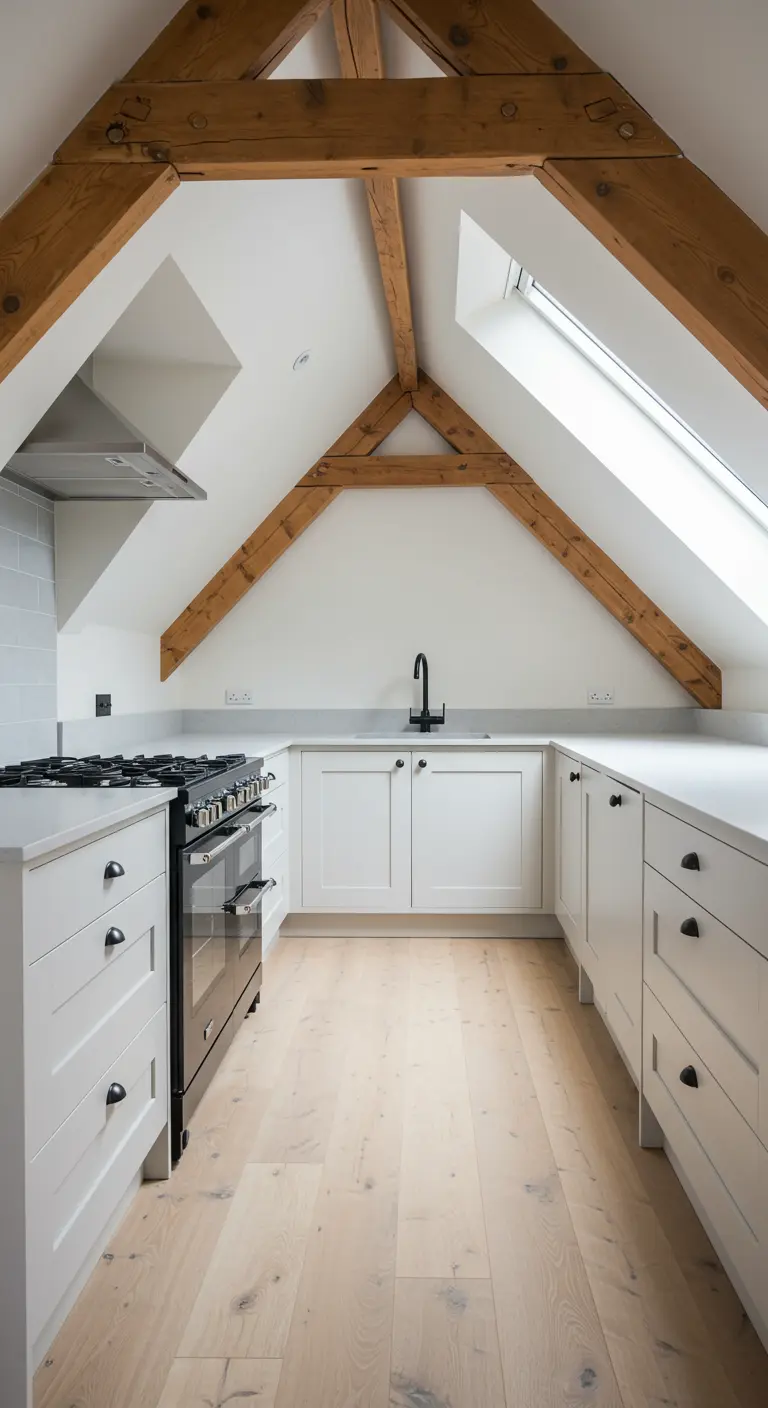
When your room has incredible structural elements like these exposed wood beams, your job is to celebrate them.
Keep the cabinetry, countertops, and walls neutral and understated to allow the architecture to be the hero.
The natural wood of the beams connects visually with the light wood flooring, creating a cohesive and powerfully authentic frame for the entire kitchen.
7. Create Visual Height with Two-Tone Cabinetry
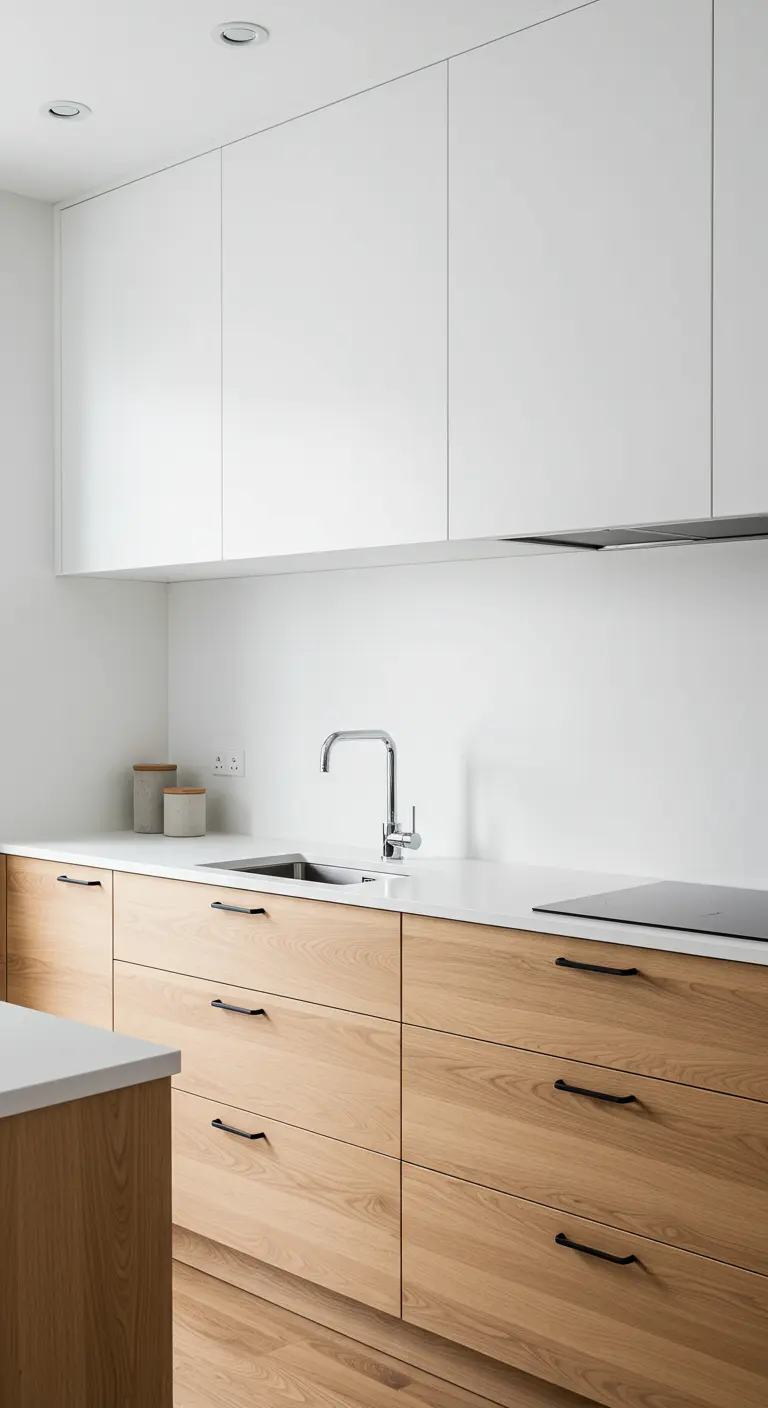
Ground your kitchen with warm, natural wood base cabinets while using crisp white for the uppers.
This designer strategy makes the ceiling feel higher and the room appear more spacious and airy.
By choosing handleless upper cabinets, you create a seamless plane that blends into the wall, further enhancing the effect of lightness.
The simple black pulls on the lower cabinets add just the right amount of graphic definition.
8. Master the Art of Curated Open Shelving
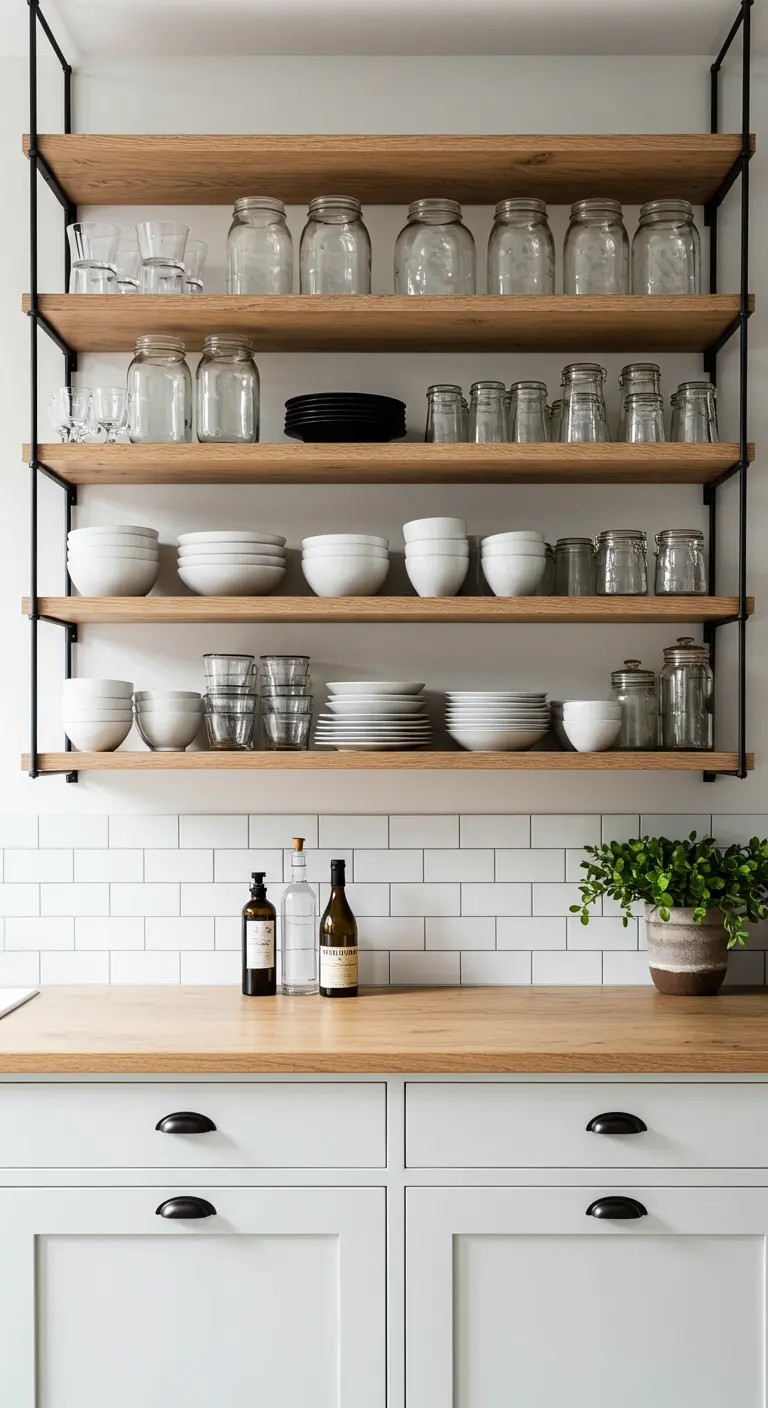
For open shelving to feel serene and not stressful, it must be intentionally styled.
Group like items together: stack your white everyday bowls, line up your clear glasses, and create neat rows.
This is not storage for mismatched items; it is a functional display.
Think in terms of texture, color, and repetition to create a rhythm that is calming to the eye.
9. Define Your Dining Zone with a Statement Pendant
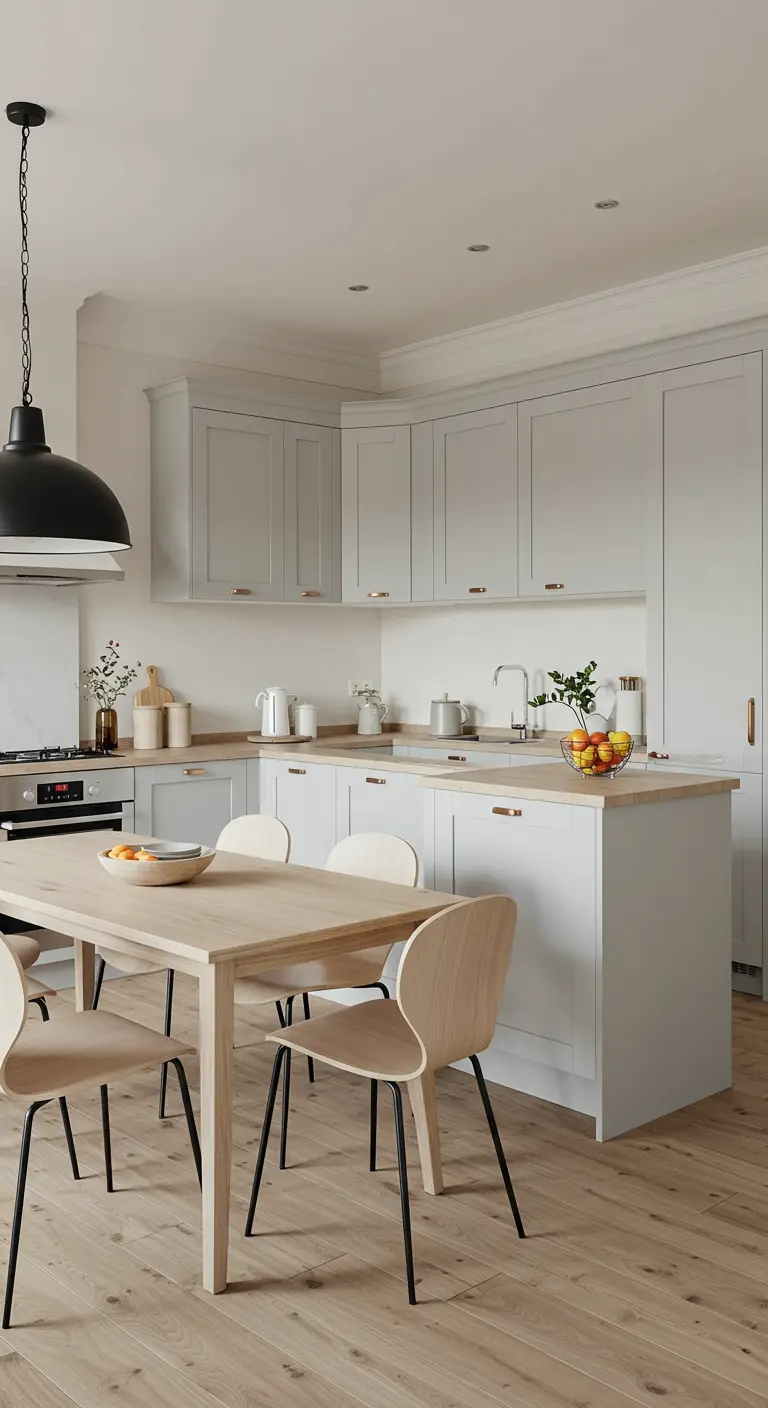
In an open-concept space, a large, low-hanging pendant is a powerful tool for defining the dining area.
This oversized black dome acts as a strong visual anchor, separating the table from the kitchen work zone.
Its bold shape and color connect to the darker elements in the room, like the chair legs, creating a sense of deliberate design cohesion.
10. Add Subtle Texture with a Glossy Backsplash

To add depth to a neutral kitchen without adding color, focus on texture.
A backsplash of glossy, slightly irregular tiles, often called Zellige tiles, catches the light in a dynamic way, creating movement and reflection.
Its handcrafted feel provides a beautiful organic contrast to the clean lines of the Shaker cabinets and the smooth matte hardware.
11. Frame the View and Let Nature Be Your Art
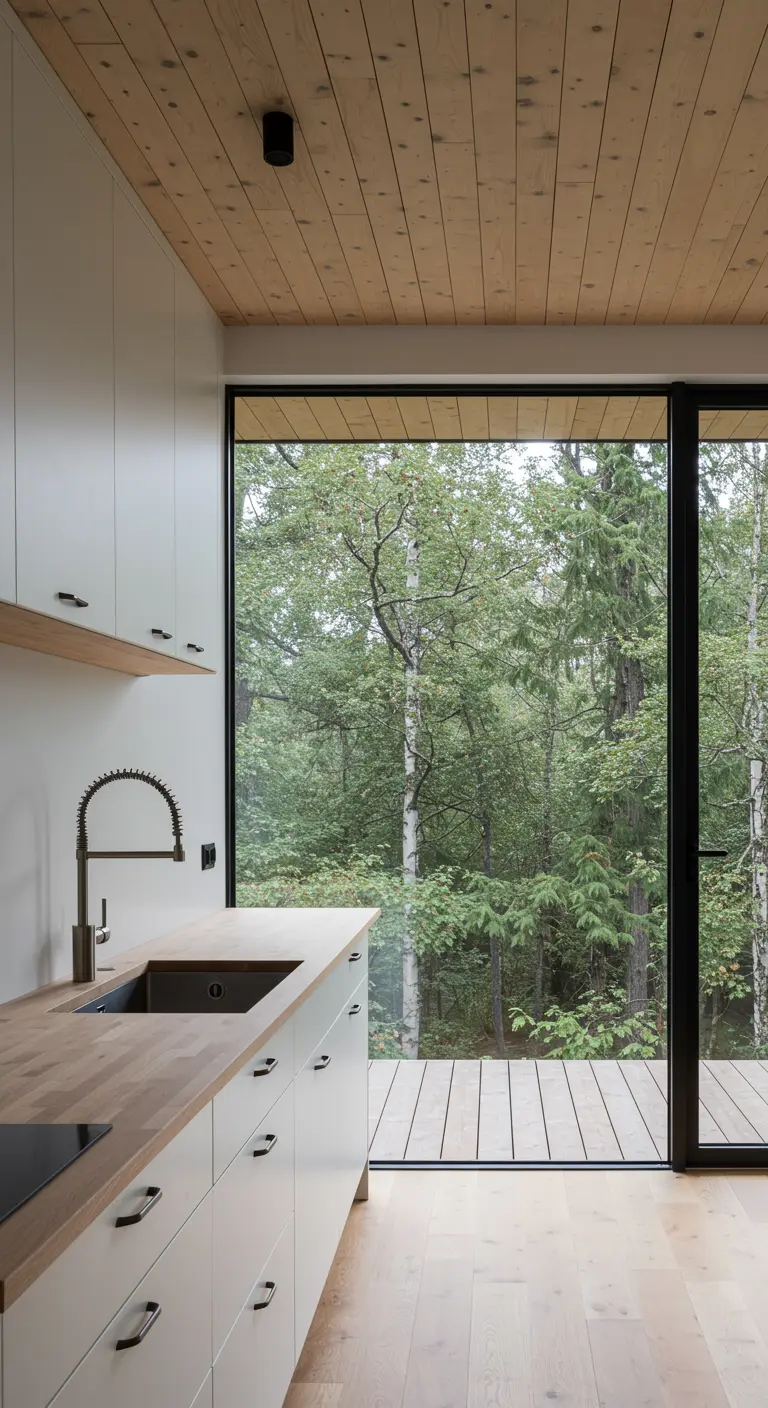
If you are lucky enough to have a beautiful view, make it the focal point of your kitchen.
A large window with a slim, dark frame acts like a piece of living art, and everything else in the room should be designed to support it.
Keep the interior palette simple—white, light wood, and black accents—to complement, rather than compete with, the natural beauty outside.
12. Embrace the Honesty of Plywood Cabinetry
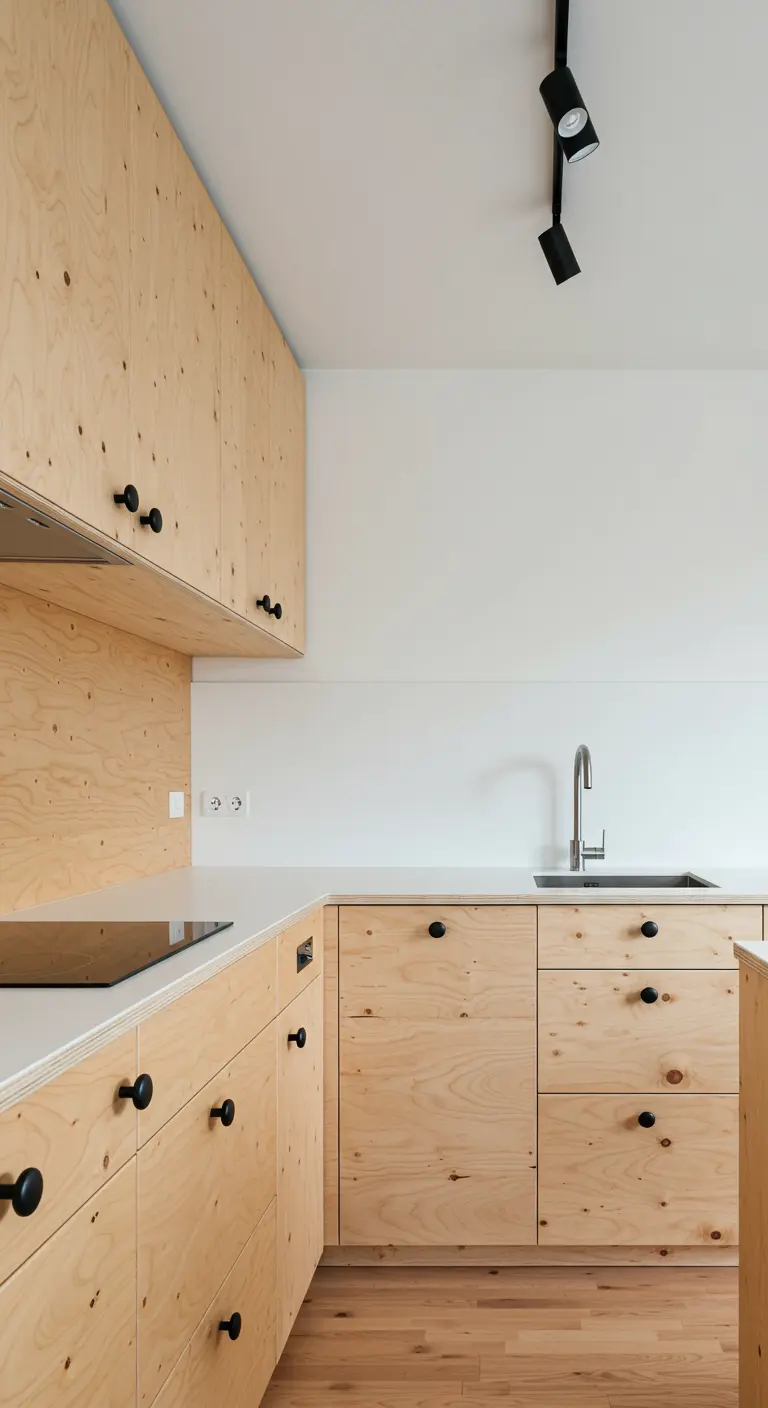
High-quality plywood is a sophisticated and warm material for a modern kitchen.
The visible layered edges and natural wood grain bring an honest, textural quality that feels both minimalist and organic.
Paired with simple matte black knobs and a crisp white countertop, the look is elevated and intentional, channeling a Japandi-inspired sensibility.
13. Soften an Industrial Loft with a Wood Island
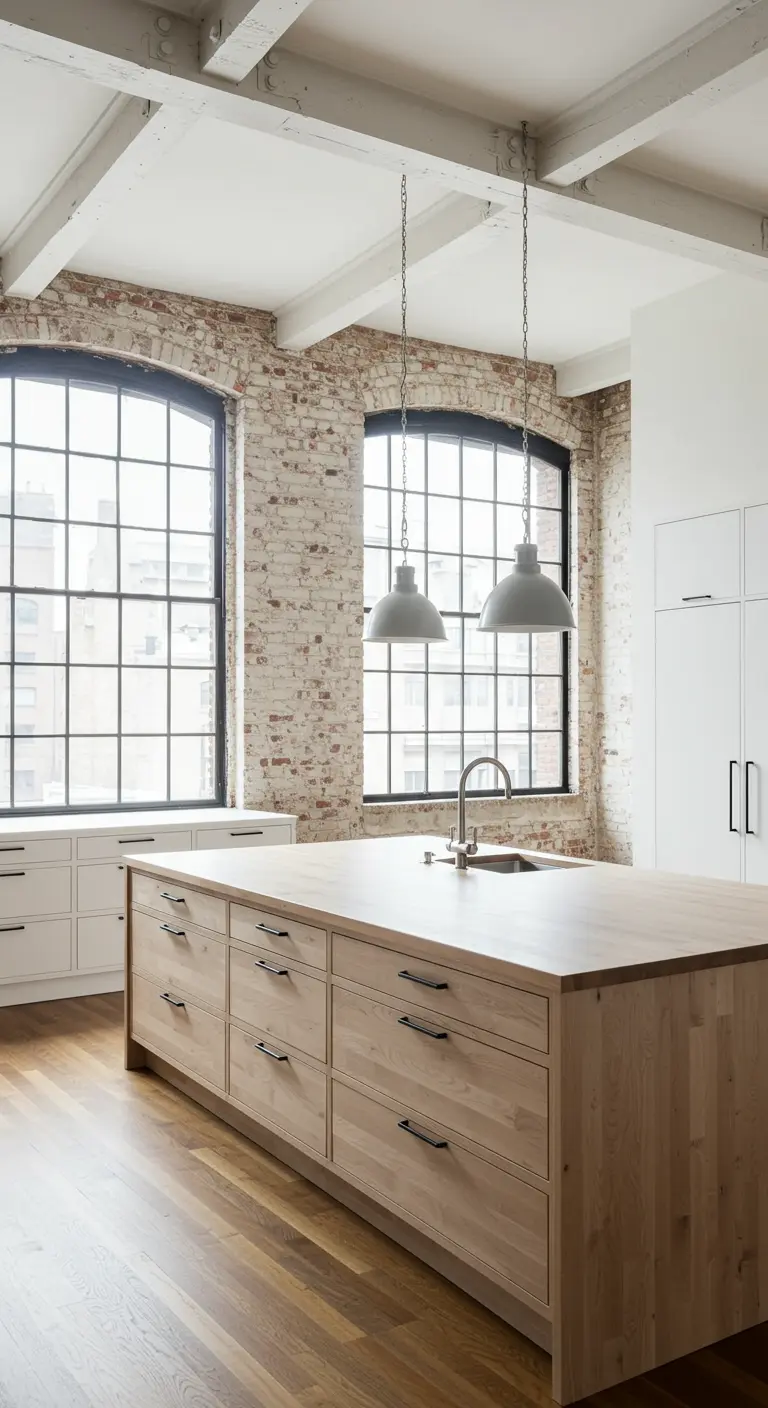
In a space with strong industrial features like exposed brick and metal-framed windows, a substantial light wood island adds essential warmth.
It provides a necessary organic counterpoint to the cool, hard surfaces, making the room feel more like an inviting home.
The clean lines and simple hardware of the island ensure the overall aesthetic remains modern and uncluttered.
14. Ground a White Kitchen with a Dark Slate Floor
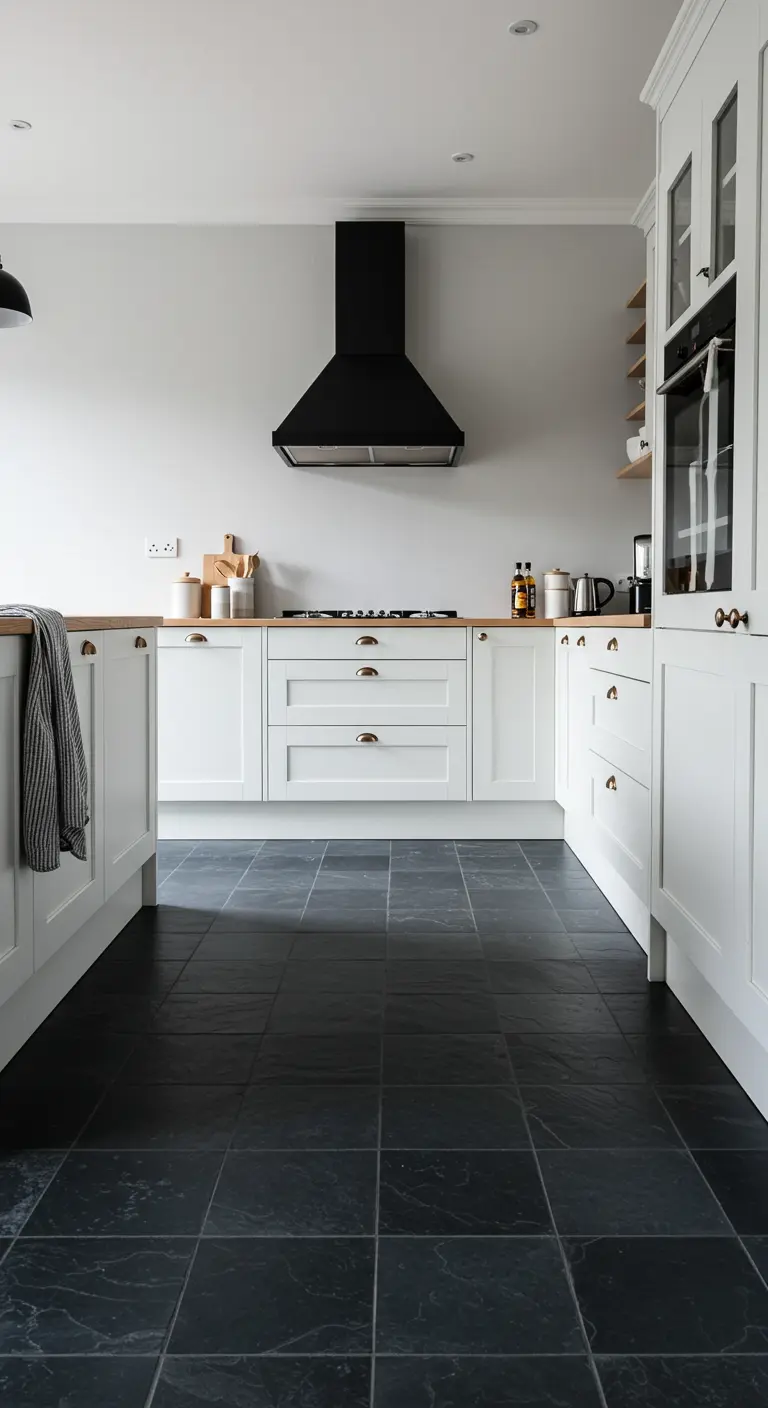
A dark floor provides a dramatic and practical foundation for an otherwise light and airy kitchen.
This black slate tile anchors the room, making the white cabinetry appear even brighter by contrast.
By adding a bold black range hood, you create a strong vertical connection between the floor and ceiling, resulting in a balanced and intentional composition.
15. Activate a Corner with Floating Shelves
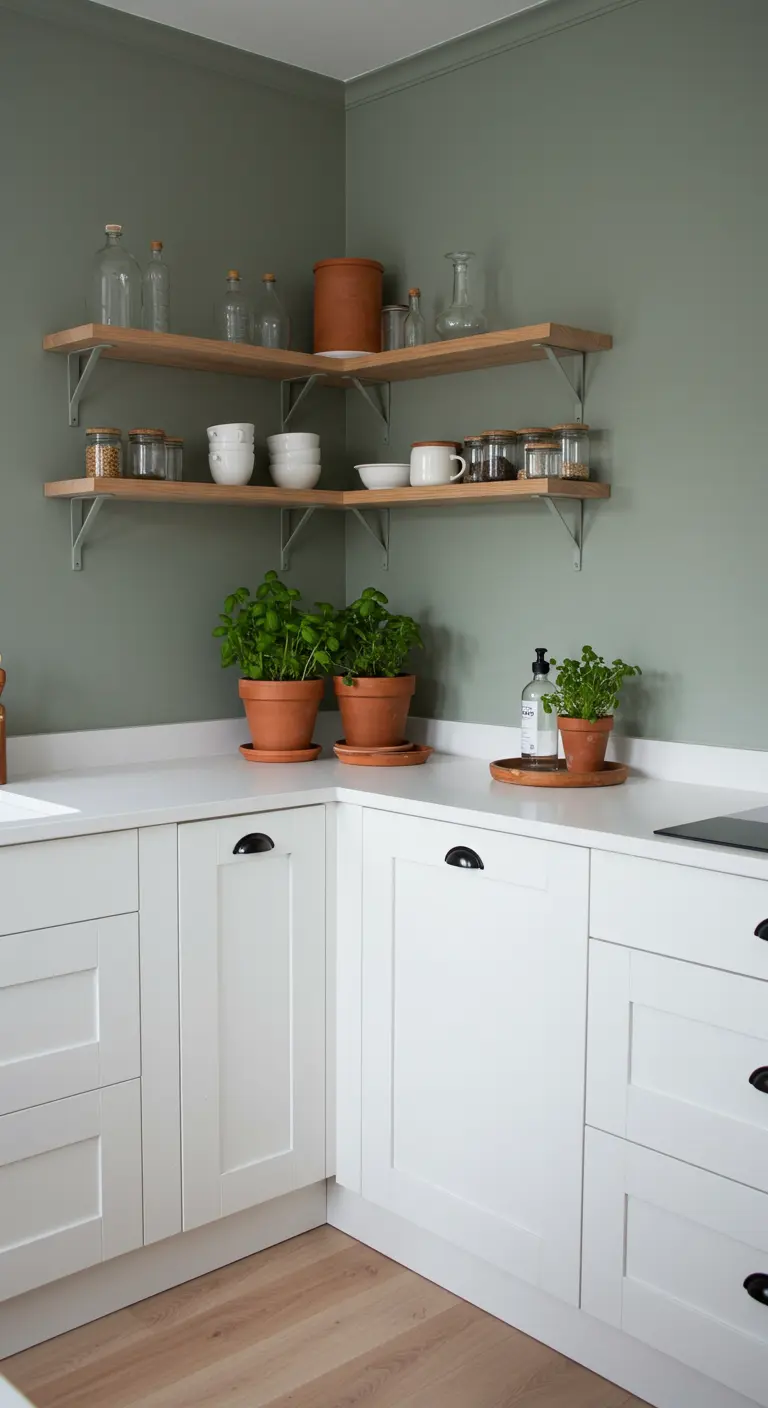
Turn an awkward, underutilized corner into a beautiful and functional feature.
Instead of a clunky upper cabinet, L-shaped floating shelves in a warm wood tone open up the corner visually.
They provide the perfect display space for everyday essentials, cookbooks, or a few small terracotta pots with herbs, adding a layer of life and personality.
16. Create an Intimate Nook with Built-In Seating
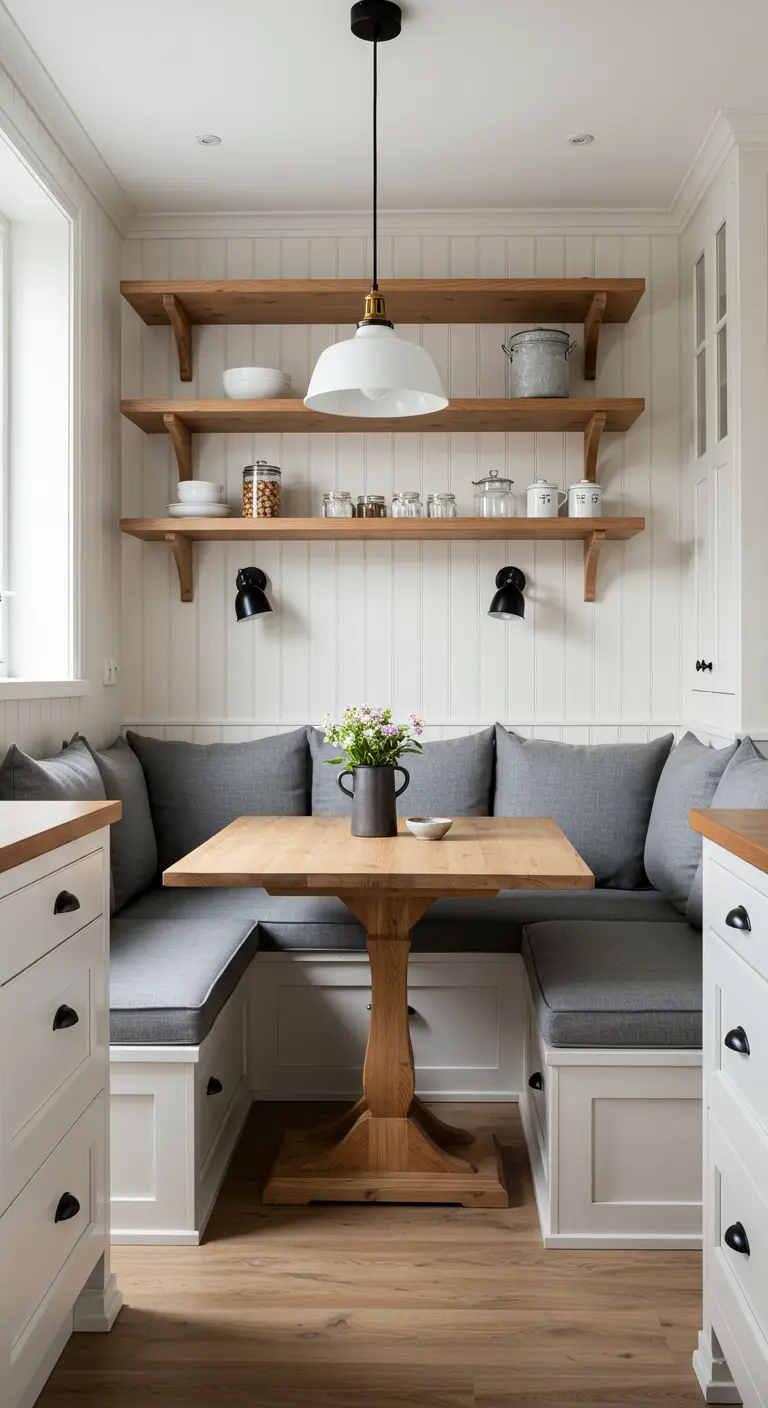
A built-in banquette is the ultimate space-saving solution for creating a cozy dining area.
It maximizes seating in a small footprint and provides an opportunity for hidden storage underneath the benches.
A pedestal table is the perfect pairing, as it eliminates corner legs and makes sliding in and out easy.
The thick grey cushions add comfort, inviting you to linger long after the meal is over.
17. Wrap the Room in Wood for Architectural Depth
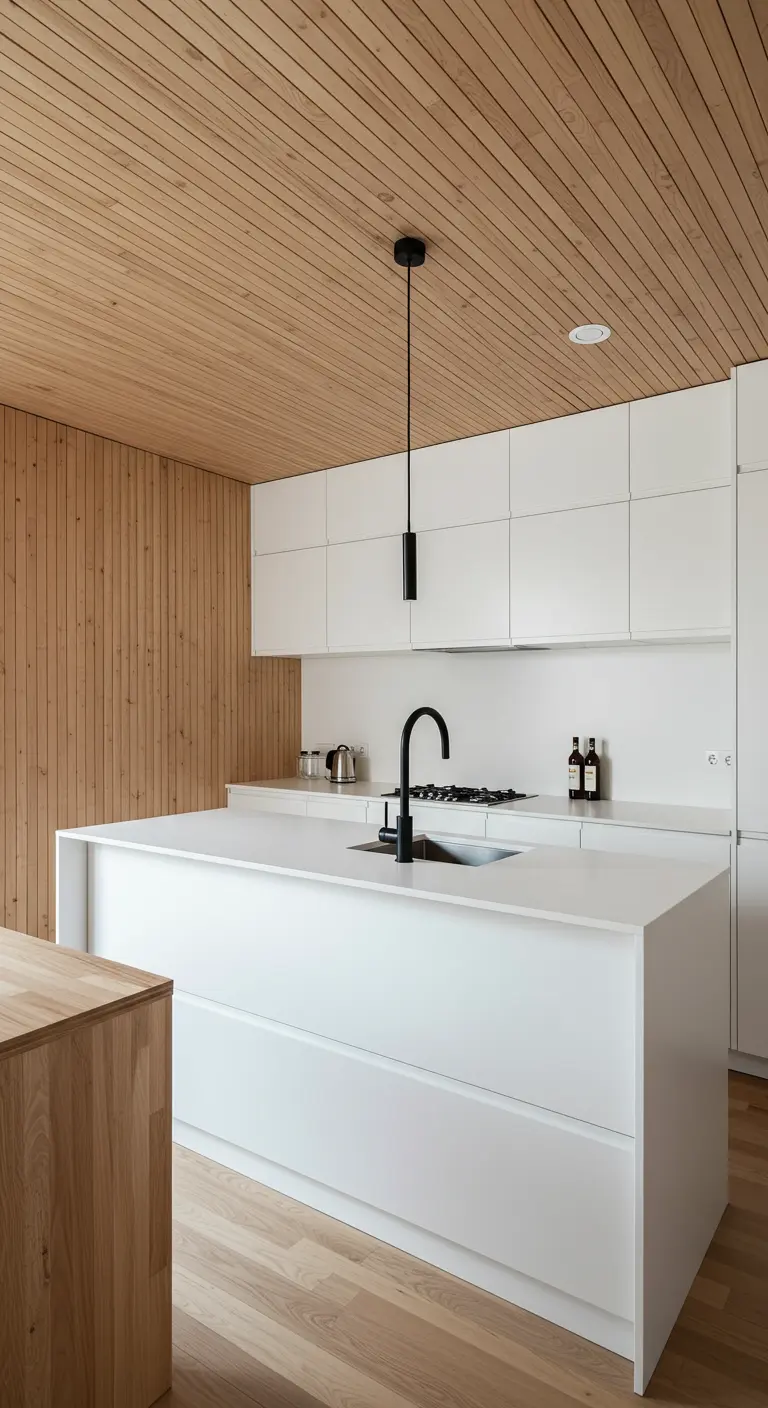
For a truly immersive and warm aesthetic, clad both the ceiling and a feature wall in the same light wood paneling.
This powerful architectural choice envelops the space, making the sleek white cabinets and island stand out with crisp contrast.
It creates a sense of an intimate, carefully crafted sanctuary and adds immense textural interest.
18. Introduce Rhythm with a Fluted Wood Backsplash

Move beyond tile and consider a fluted or slatted wood accent for your backsplash or feature wall.
The repeating vertical lines create a beautiful, calming rhythm and the illusion of height.
It’s an unexpected way to introduce the warmth and texture of wood, adding a layer of bespoke detail that feels both modern and deeply organic.
19. Choose an Island That Feels Like Furniture
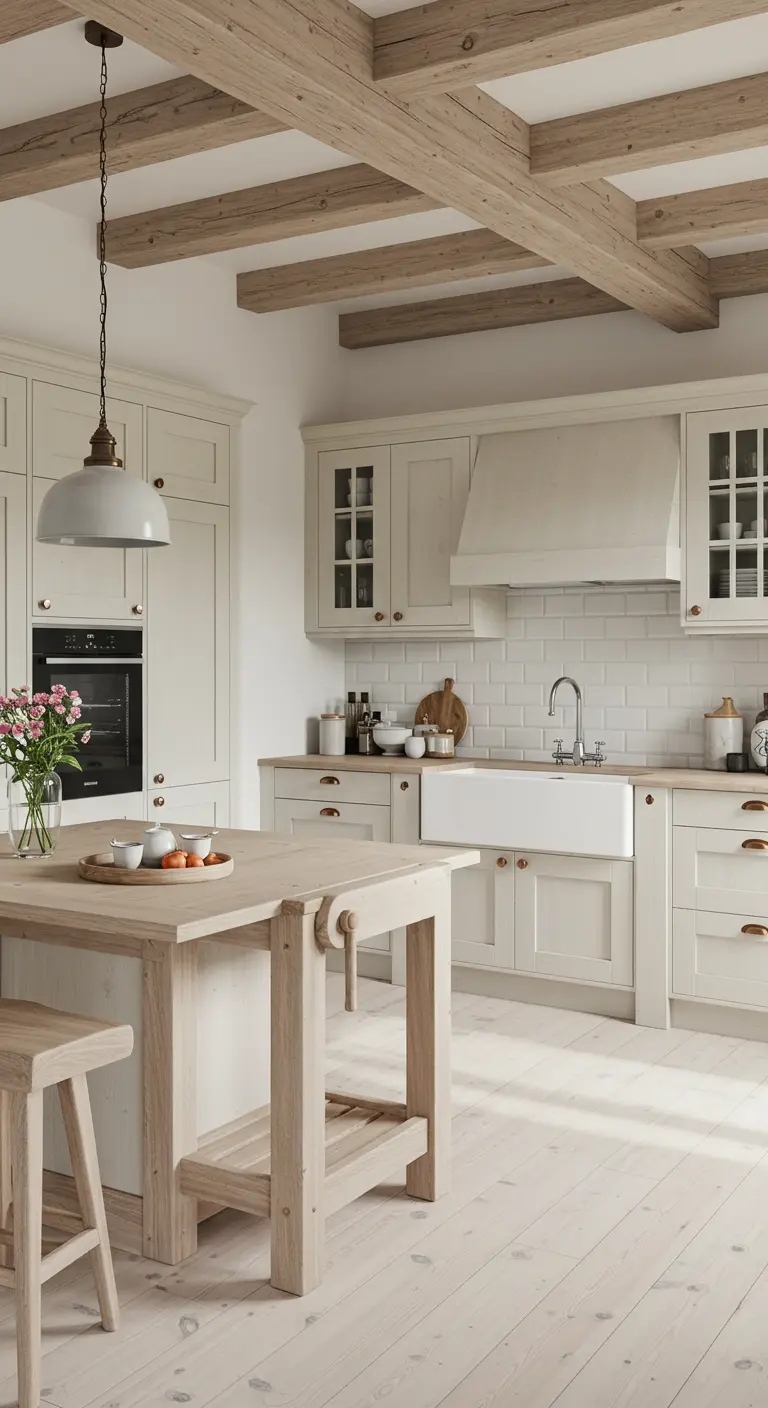
Instead of a standard block of cabinetry, select an island that feels like a freestanding piece of furniture, such as a vintage workbench.
This approach adds instant character and a sense of history to a new kitchen.
The open lower shelf keeps it from feeling heavy and offers practical storage for bowls or baskets, enhancing the room’s warm, rustic charm.
20. Play with Finishes for Subtle Sophistication
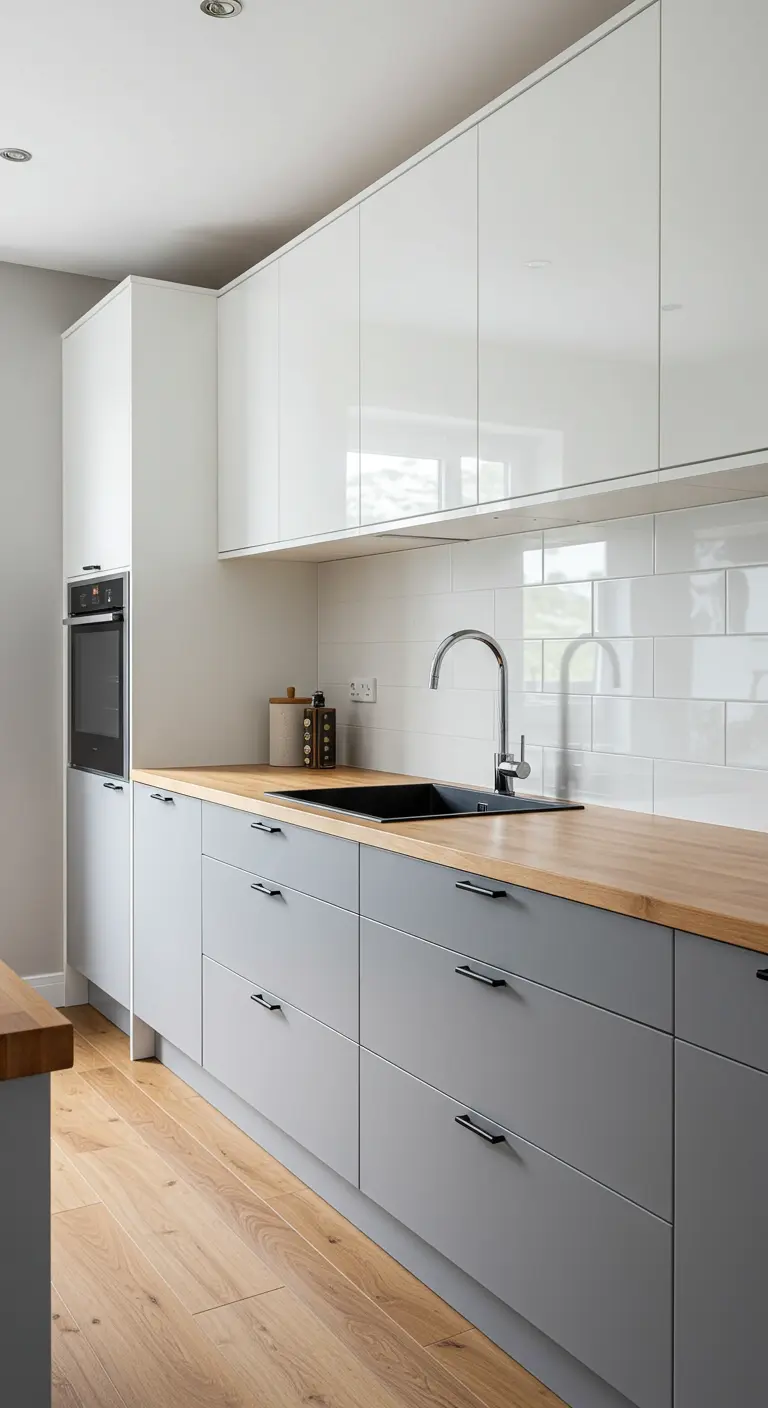
Create quiet visual interest by mixing different finishes within the same color palette.
Pairing high-gloss white upper cabinets with matte grey lower cabinets is a sophisticated choice.
The glossy uppers reflect light, making the space feel bigger and brighter, while the matte lowers ground the design and are excellent at hiding fingerprints.
21. Build a Monochromatic Palette of Textures
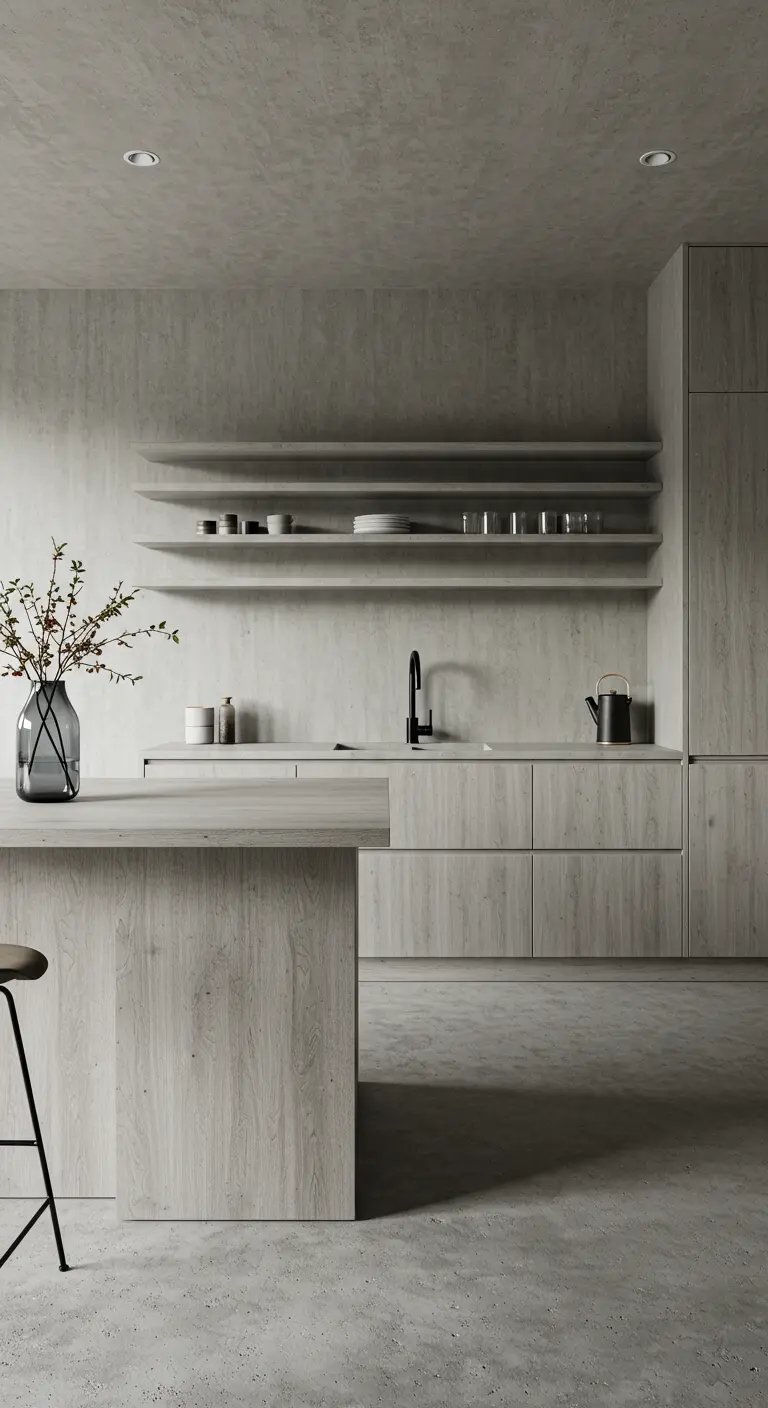
A minimalist design can feel incredibly rich when you focus on a monochromatic palette of varied textures.
Here, concrete-like finishes on the walls and floors are paired with pale, gray-washed wood cabinets.
The color is consistent, but the experience is tactile and layered—from the smooth countertops to the linear grain of the wood.
This is quiet luxury at its best.
22. Elevate the Everyday with a Bold Piece of Art
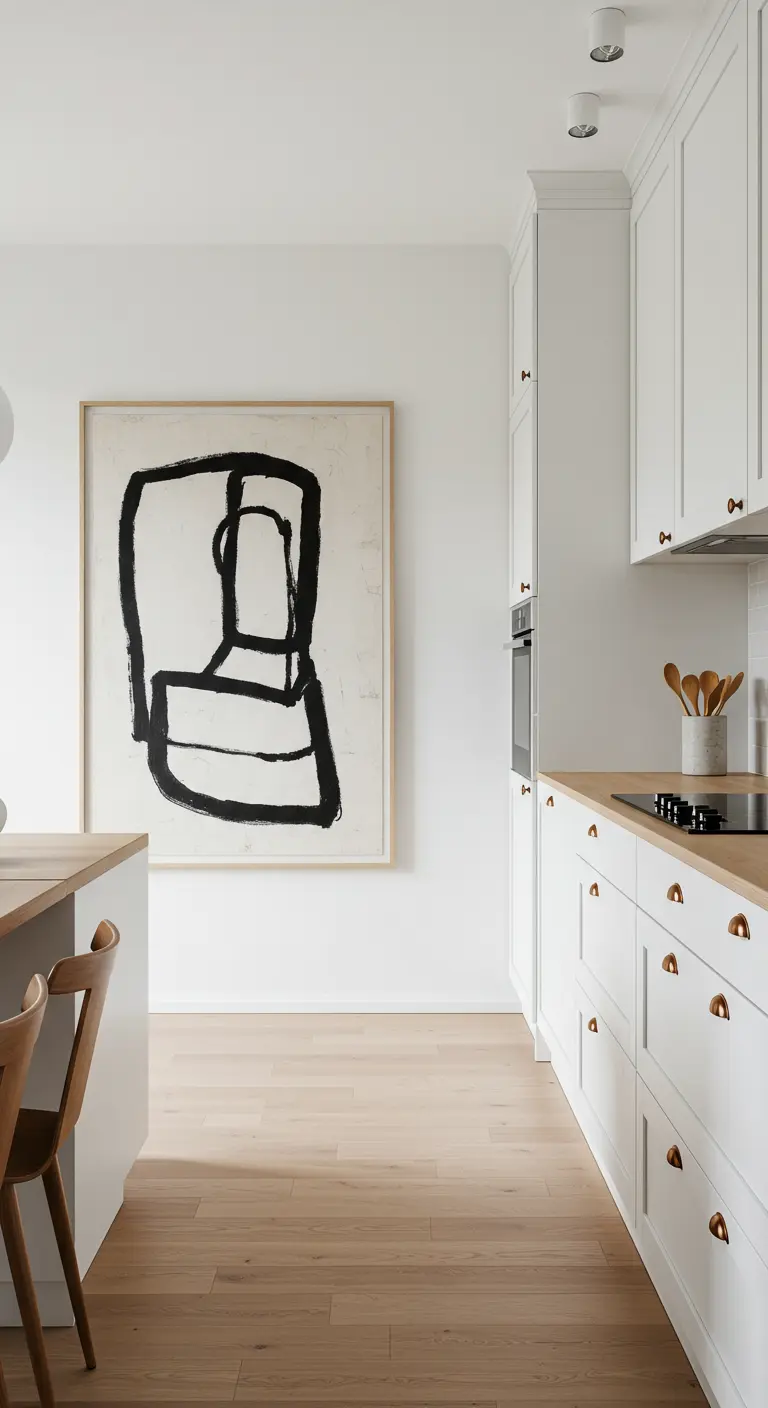
Treat your kitchen as you would any other living space in your home by giving it the gift of art.
A single, large-scale abstract painting can serve as a powerful focal point, injecting personality and soul into a functional room.
The bold black brushstrokes here beautifully echo the simple hardware on the cabinets, tying the entire design together with intention.
23. Strike the Perfect Balance of Storage

The most functional kitchens balance hidden storage with open, accessible surfaces.
Use floor-to-ceiling cabinets to conceal appliances and less-used pantry items, keeping the visual landscape calm and uncluttered.
Then, add open shelving in your primary work zone for everyday plates, glasses, and cooking oils. This creates a space that is both efficient and beautifully breathable.
24. Erase the Line Between Inside and Out
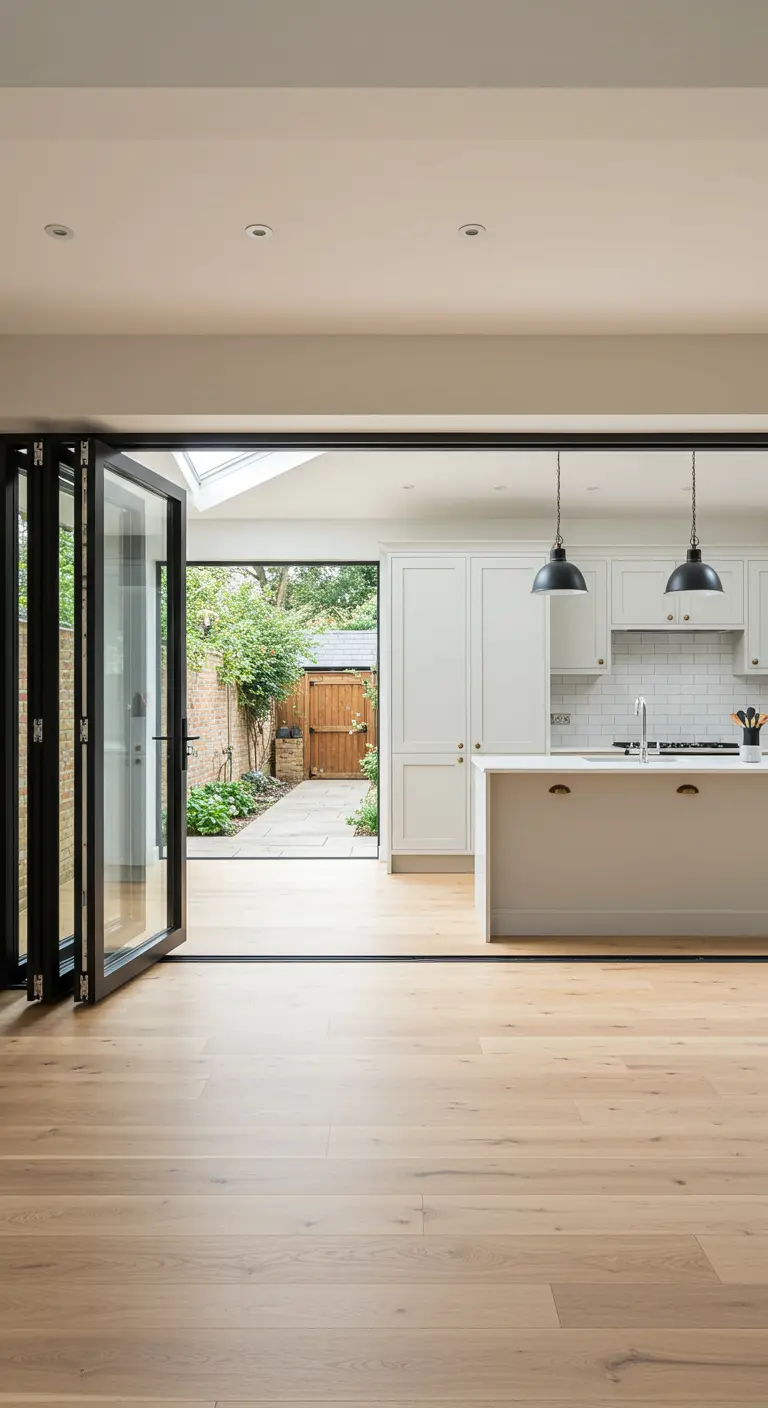
If your kitchen opens to a garden or patio, fully retractable bifold doors are a transformative investment.
They effectively dissolve the wall, merging your indoor and outdoor living areas into one seamless space.
The strong black frames provide a modern, graphic outline that ties in with interior hardware, while the influx of natural light and air makes the kitchen feel boundless.
